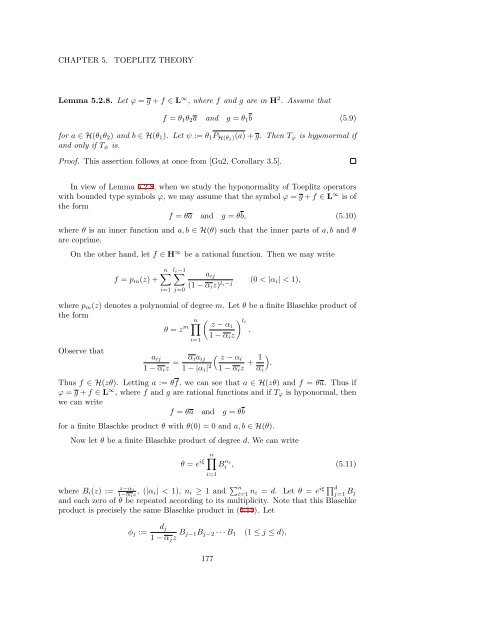Woo Young Lee Lecture Notes on Operator Theory
Woo Young Lee Lecture Notes on Operator Theory
Woo Young Lee Lecture Notes on Operator Theory
Create successful ePaper yourself
Turn your PDF publications into a flip-book with our unique Google optimized e-Paper software.
CHAPTER 5.<br />
TOEPLITZ THEORY<br />
Lemma 5.2.8. Let φ = g + f ∈ L ∞ , where f and g are in H 2 . Assume that<br />
f = θ 1 θ 2 a and g = θ 1 b (5.9)<br />
for a ∈ H(θ 1 θ 2 ) and b ∈ H(θ 1 ). Let ψ := θ 1 P H(θ1 )(a) + g. Then T φ is hyp<strong>on</strong>ormal if<br />
and <strong>on</strong>ly if T ψ is.<br />
Proof. This asserti<strong>on</strong> follows at <strong>on</strong>ce from [Gu2, Corollary 3.5].<br />
In view of Lemma 5.2.8, when we study the hyp<strong>on</strong>ormality of Toeplitz operators<br />
with bounded type symbols φ, we may assume that the symbol φ = g + f ∈ L ∞ is of<br />
the form<br />
f = θa and g = θb, (5.10)<br />
where θ is an inner functi<strong>on</strong> and a, b ∈ H(θ) such that the inner parts of a, b and θ<br />
are coprime.<br />
On the other hand, let f ∈ H ∞ be a rati<strong>on</strong>al functi<strong>on</strong>. Then we may write<br />
f = p m (z) +<br />
n∑<br />
l∑<br />
i−1<br />
i=1 j=0<br />
a ij<br />
(1 − α i z) li−j (0 < |α i | < 1),<br />
where p m (z) denotes a polynomial of degree m. Let θ be a finite Blaschke product of<br />
the form<br />
∏<br />
n ( ) li<br />
z −<br />
θ = z m αi<br />
.<br />
1 − α i z<br />
Observe that<br />
i=1<br />
a ij<br />
1 − α i z = α ia ij<br />
1 − |α i | 2 ( z − αi<br />
1 − α i z + 1 α i<br />
)<br />
.<br />
Thus f ∈ H(zθ). Letting a := θf, we can see that a ∈ H(zθ) and f = θa. Thus if<br />
φ = g + f ∈ L ∞ , where f and g are rati<strong>on</strong>al functi<strong>on</strong>s and if T φ is hyp<strong>on</strong>ormal, then<br />
we can write<br />
f = θa and g = θb<br />
for a finite Blaschke product θ with θ(0) = 0 and a, b ∈ H(θ).<br />
Now let θ be a finite Blaschke product of degree d. We can write<br />
θ = e iξ<br />
n ∏<br />
i=1<br />
B ni<br />
i , (5.11)<br />
where B i (z) :=<br />
z−αi<br />
1−α , (|α iz i| < 1), n i ≥ 1 and ∑ n<br />
i=1 n i = d. Let θ = e iξ ∏ d<br />
j=1 B j<br />
and each zero of θ be repeated according to its multiplicity. Note that this Blaschke<br />
product is precisely the same Blaschke product in (5.11). Let<br />
ϕ j :=<br />
d j<br />
1 − α j z B j−1B j−2 · · · B 1 (1 ≤ j ≤ d),<br />
177













